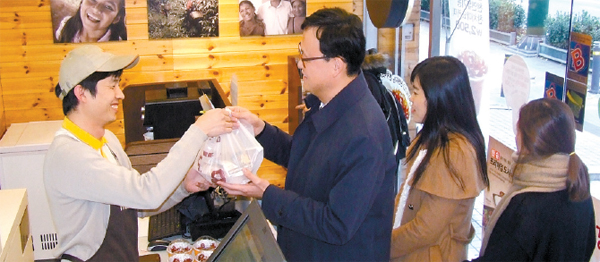Little lunchbox is a big business

Customers line up at a Hansot store in Gyodae, southern Seoul, recently. Due to demographic shifts favoring people living alone and lifestyle changes, takeout lunchboxes are a booming business, luring new companies at both low and high ends. Provided by ChangupKorea Consulting
And the recent boom in camping as a leisure activity has also helped.
The takeout lunch restaurant industry is now estimated to be a 2 trillion won ($1.8 billion) industry and is expanding rapidly.
“In the past, the industry didn’t grow very fast because the lunchbox didn’t fit into the Korean culture of enjoying a meal with hot soups,” said Kang Byung-oh, a Chung-Ang University professor who specializes in business start-ups. “But the industry is likely to grow rapidly thanks to demographic changes in Korea, such as an increasing number of single-person households and lifestyle changes, including rapid expansion of leisure activities.”
According to Statistics Korea, as of the end of 2010, single-person households had more than doubled in 10 years. There are 4.1 million households with only a single resident compared with 2.2 million in 2000. Single households now account for 24 percent of all households, up from 15.5 percent in 2000.
Already established lunchbox chains are stepping up their competitiveness by developing new menus while those jumping into the race late are vying for a spot in the market through differentiated concepts.
In August, market leader Hansot introduced dakgangjeong, crispy chicken marinated in sweet and spicy sauce. The company has been preparing the item for a year. In Korea, marinated crispy chicken isn’t considered a traditional meal. It’s more like a quick snack like a hotdog. Hansot’s main purpose in developing the item was to ramp up revenues during the time between lunch and dinner when customers are scarce.
Since 2009, Hansot has been adopting an interior design in its stores that resembles a cafe with tables. In the past, Hansot stores were entirely takeout, with plastic lunchboxes handed to customers over the counter. Some stores even sell other food items such as cup ramen, soft drinks and even salads.
One of the reasons Hansot has become No. 1 in the industry is because it has kept the prices of its lunchboxes cheap ever since it opened its first shop in 1993.
A single lunchbox sells for between 3,000 won ($2.82) and 5,000 won. Over the past 20 years, the price of its lunchboxes has only increased 20 percent. In contrast, the average price of one of the nation’s most loved dishes, the Korean-Chinese delight jajangmyeon, or noodles with black bean sauce, has doubled in the same period.
More recent entrants to the industry have their own unique concepts. Bentorang is a chain offering high-quality, Japanese-style lunchboxes selling for 6,000 won to 10,000 won. The lunchboxes comes with various high-quality side dishes including tuna tataki, marinated unagi or eel, and even salmon sushi. There are 23 different items to pick from.
Bon Dosirak, which claims to be a premium alternative to Hansot, tries to set itself apart by offering healthy rice. Instead of white rice, the chain mixes white rice with brown rice, black rice or seaweed. The most expensive lunch item by Bon Dosirak is 10,900 won.
Sanchae Dosirak’s specialty is offering simple items made from wild herbs and vegetables. One such offering is rolled up rice with wild herbs and vegetables. The company lowered its production costs by getting a direct supply of herbs and vegetables from farms in Yangpyeong, Gyeonggi, through an agreement it made with the local government.
The company Tomato tries to appeal to people living alone by using microwaveable containers.
These Korean companies are also getting some competition from overseas establishments. The world’s leading Japanese takeout company, Hotto Motto, which launched in the Korean market in June 2012, was the first in Korea to launch a menu of udon, or Japanese thick noodles. Customers could pick various types of udon lunchboxes, including one dipped in curry.
Some non-takeout restaurants are jumping into the business as well. Saboten, a Japanese restaurant brand that specializes in pork cutlets, launched Saboten Deli at the IFC Mall in Yeouido in August 2012 and started selling takeout cutlets.
Misoya, a low-end Japanese restaurant brand, launched a chain that specializes in takeouts in June. There are currently two Misoya takeout stores in the country. Both are located in the heart of Gangnam, southern Seoul; one in Apgujeong and another in Bangbae.
High-end Japanese restaurants and hotels are trying to jump on the bandwagon, too. Their takeout lunches, however, are much more expensive, ranging between 10,000 won to 60,000 won.
The targeted consumers are high-income office workers. Despite their steep price tags, they are gaining popularity among people who think takeout lunches can be a treat.
Family restaurant chain Outback Steakhouse is offering a premium takeout lunch menu priced between 9,900 won and 25,000 won. The world’s largest conveyor belt sushi brand, Sushiro, is selling a takeout lunch priced between 8,800 won and 15,500 won.
The Seoul Palace Hotel, located near Seorae Village in Seocho District, southern Seoul, is selling lunch takeouts costing as much as 60,000 won. The hotel even offers delivery of its lunchboxes.
The Japanese restaurant Irodori at the Renaissance Seoul Hotel in Gangnam sells Japanese lunchboxes, or bento boxes, for 50,000 won and 60,000 won.
Kang of Chung-Ang University, however, raised concerns about the sudden interest in the takeout lunch business. The professor hinted a takeout franchise that serves poor-quality food could leave a bad mark and hinder the industry’s prospects.
“Some of the unverified takeout lunch franchises could have a negative impact on the overall market,” said Kang.
The professor said for those who are considering opening a store, they need to make sure their kitchen system is well organized and that fresh food is quickly packaged and served to customers.
BY KIM YOUNG-MIN [ojlee82@joongang.co.kr]










with the Korea JoongAng Daily
To write comments, please log in to one of the accounts.
Standards Board Policy (0/250자)